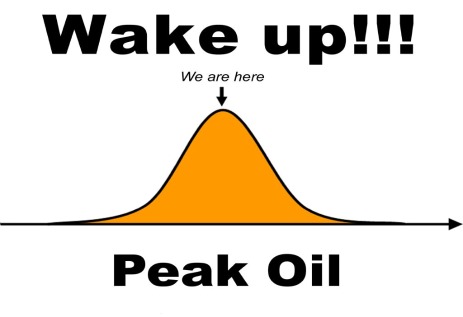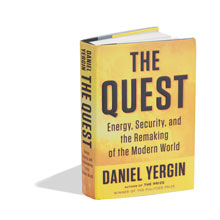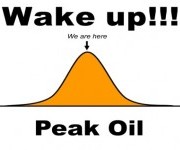 World-famous energy historian and analyst Daniel Yergin has a new book out, a sequel to his Pulitzer-winning book The Prize. His new book — The Quest: Energy, Security, and the Remaking of the Modern World — is another tome, and has been hailed as “masterly.”
World-famous energy historian and analyst Daniel Yergin has a new book out, a sequel to his Pulitzer-winning book The Prize. His new book — The Quest: Energy, Security, and the Remaking of the Modern World — is another tome, and has been hailed as “masterly.”
But as I read through it, I found many holes in his arguments, use of questionable data, and errors in describing what others have said — most of this centered around his discussion of ideas of peak oil. And then he repeated these problems in the Wall Street Journal, kicking off promotion of his book with an article titled “There Will Be Oil,” in which he tries to deflate fears about peak oil.
So I’ve written a series of posts — five so far — detailing the problems with Yergin’s arguments.
Below I sum up my series of posts, and they’re available in full on my site. But first I’ll give a brief background on the idea of peak oil.
 The idea of peak oil is that oil production can’t keep going up and up forever. The most basic reason is that our planet is finite. Even if it were a giant oil-filled bon-bon, if consumption kept growing and growing at the kinds of rates we’ve seen in the 20th century, then we’d use up all that oil in less than a millennium. If we drilled as many wells and pumped as much oil as we could, still the production would tend to reach a maximum output, and then would gradually decline from there.
The idea of peak oil is that oil production can’t keep going up and up forever. The most basic reason is that our planet is finite. Even if it were a giant oil-filled bon-bon, if consumption kept growing and growing at the kinds of rates we’ve seen in the 20th century, then we’d use up all that oil in less than a millennium. If we drilled as many wells and pumped as much oil as we could, still the production would tend to reach a maximum output, and then would gradually decline from there.
It’s kind of like Usain Bolt‘s ability to run over the course of his life. At first, he couldn’t even crawl. Then he learned to run across a room. Now, at age 25, he’s the fastest man alive — but he won’t be able to keep running that fast forever. He’ll get old, have some injuries, and gradually slow down. Right now, though, he’s still at his peak, and is amazing.
Most conceptions of peak oil describe it as something that is forced on us, that happens despite our wishes. It is possible that we would choose to not burn a lot of oil and leave it in the ground — and that could also result in a peak and decline of oil as well. But there seems to be little sign that we’re going to do that.
So for those who argue against peak oil — and there are many — it seems they only have two other options: that we’ll choose to give up on oil before it gives up on us, or that we’ll colonize other planets and use their oil. But as long as we’re stuck on Earth and addicted to oil, then it seems that we’ll have to deal with peak oil. (Energy Bulletin has a more detailed but still understandable primer on peak oil.)
So if peak oil is basically unescapable, the big question is: When will we reach this turning point?
The most famous peak oil forecaster was M. King Hubbert, a geologist who worked for Shell Oil and the U.S. Geological Survey, and who predicted that U.S. oil production would reach its peak around 1965 or 1970. When production did peak in 1970, and start a long decline, then, as Yergin writes in The Quest, “Hubbert appeared more than vindicated.”
Why only “appeared”? Because, Yergin argues, Hubbert’s forecast for U.S. oil production over the longer term was off, and the country now produces about four times as much as Hubbert had forecast for 2010.
But Yergin is splitting hairs, as a graph from Yergin’s own company, IHS CERA, makes clear. It shows Hubbert’s forecast compared with actual production. Although neither Yergin’s book nor CERA’s report want to give Hubbert much credit, it seems to me Hubbert got the overall shape of things remarkably right. I cover this in more detail in my first part of the series, “Peak Oil Projection Was Far Off?“
To try to explain why Hubbert’s forecast — and those of his successors — was (supposedly) far off the mark, Yergin attacks their forecasting methods. The problem is, he completely misrepresents what they were doing.
In The Quest, Yergin writes: “Hubbert used a statistical approach to project the decline curve that one might encounter in some — but not all — oil fields, and then assume that the United States is one giant oil field.”
If this is what he actually did, it would be worthy of ridicule — but it’s not the approach Hubbert actually took. Yergin’s explanation is so far off the mark it suggests he never read the paper he cites — or if he did, perhaps it was a long time ago and he only remembers a caricature of it.
In his 1956 talk, Hubbert never discussed the peak and decline of individual oil fields. His idea, instead, was that the production from a large area — such as the U.S. — was the sum of a whole bunch of oil fields, and their ups and downs would tend to average out, giving you a smooth curve. The simplest kind of curve for trying to represent this, he thought, was a bell-shaped curve.
More on all this at my second post, “One Giant Oil Field?“
Then Yergin marshals evidence to argue that there is plenty of oil, saying that we are finding oil faster than we’ve been using it in recent years.
It appears that Yergin is drawing data from the widely used Statistical Review of World Energy, assembled every year by oil giant BP. But the figures they have for “proved reserves” — the oil fields that are already producing or are “on deck,” ready to come online soon — are questionable for many of the world’s biggest producers.
In particular, the numbers for OPEC countries in the Middle East — like Saudi Arabia, Kuwait, Iran, Iraq, and others — appear, to put it nicely, magical. Despite collectively producing a couple dozen billion barrels of oil each year, Middle East countries’ reserves, as listed in the BP report, barely budge most years. And when they do change, they always go up, never down. It’s as if a huge corporation got audited and claimed that their bank account was always exactly $572 million dollars, and never changed. It’s not realistic.
What’s more, during the time period Yergin chooses to emphasize — 2007 to 2009 — Canada and Venezuela put huge tar sands and heavy oil deposits on their books. By adding these low-quality sources, they more than doubled their proved reserves in a very short time. But it seems they won’t be able to keep adding more oil to their books at this kind of rate in the future, continuing to double and double their reserves. From 2009 to 2010, their reserves stayed exactly the same.
Why doesn’t Yergin include 2010? Or the decades before 2007? For a historian, his outlook is surprisingly short-term.
To see what more realistic figures would be — from IHS, the company Yergin works for — see my full post, “We’re Finding Oil Faster Than We’re Using It?” Spoiler: We’re using oil faster than we’re finding it, and it’s been that way for a while.
One of Yergin’s favorite arguments, it seems, is that experts have predicted peak oil many times before, and they’ve always been wrong. As Yergin writes, “This is actually the fifth time in modern history that we’ve seen widespread fear that the wor
ld was running out of oil.”
Of course, it’s a logical fallacy to say that because something didn’t happen before, it won’t happen in the future. But Yergin has repeated this argument so many times that it seems he thinks he has a real winner.
The problem is, because oil production unfolds over decades, the biggest pessimists have to be proved wrong first. It’s just simple logic. The biggest optimists, on the other hand, get to enjoy not being proved wrong for a long time — until after we pass peak oil. But just because the optimists haven’t been proved wrong yet, it doesn’t follow that they’re correct.
Also, Yergin mentions only the pessimists who turned out to be wrong, and neglects to point out there were others who were wrong because they were too optimistic. For U.S. oil, there were plenty of those optimists in the 1960s and ’70s, and I’m sure Yergin is aware of them. In the 1970s, one of the biggest sources of oil optimism was the National Petroleum Council — which Yergin is a member of today.
More on all this at my fourth post, “Only the Pessimists Have Been Wrong?“
Finally, Yergin repeatedly equates “peak oil” with “running out of oil” — as if the idea is that the wells will run dry in the next decade or something equally apocalyptic.
But the idea is actually that production will gradually peter out over many decades. In the simplest picture of peak oil, the decline phase lasts as long as the growth phase — so, the forecast says, the decline of world oil would be stretched out over more than a century.
I cover that in more detail in the fifth post, “Peak Oil = Running Out of Oil?“
What’s funny about this — or sad, depending on your mood — is that Yergin actually foresees a peak and decline in oil production, too. It’s just that he sees the peak coming decades away, around mid-century, and thinks that there will be a long plateau before the decline begins. But he gives little data to back up his peak oil forecast, or to argue that it is better than the others. It seems he just wants us to take his word for it. And, so far, it seems the world has been.



